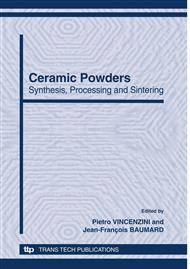p.107
p.113
p.119
p.125
p.131
p.141
p.147
p.157
p.163
Theoretical and Experimental Analyses of Colloidal Processing of Nanoparticles
Abstract:
The stability of dispersed and flocculated colloidal particles under 1 atm and applied pressure was discussed thermodynamically with the activity and chemical potential defined by Henry’s law and Raoult’s law. The calculated result under 1 atm is represented by a colloidal phase diagram as functions of surface potential and solid content of particles. Application of pressure accelerates the phase transition from dispersed to flocculated suspension. The phase transition pressure, which is observed in the applied pressure-suspension height relation during pressure filtration at a constant crosshead speed of piston, is affected by (1) particle concentration, (2) particle size, (3) surface potential, (4) degree of dissociation of polyelectrolyte dispersant and (5) applied electric field (DC and AC). The influence of above factors was discussed theoretically and experimentally.
Info:
Periodical:
Pages:
131-140
Citation:
Online since:
October 2010
Permissions:
Share:
Citation:


